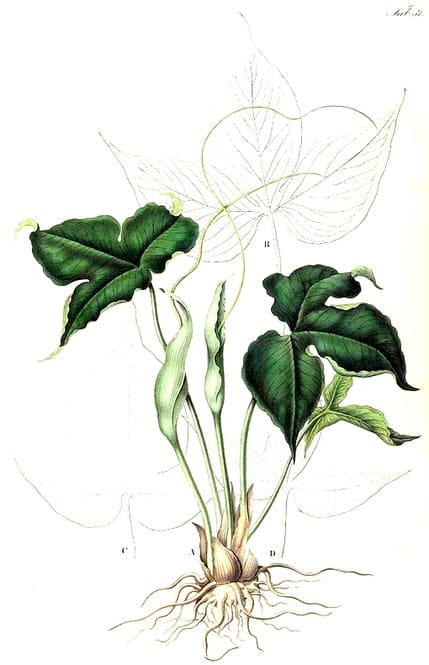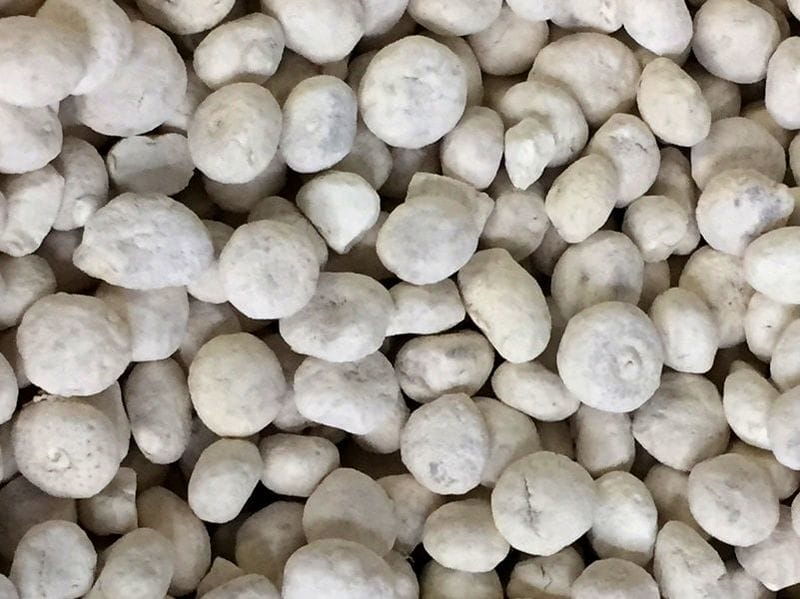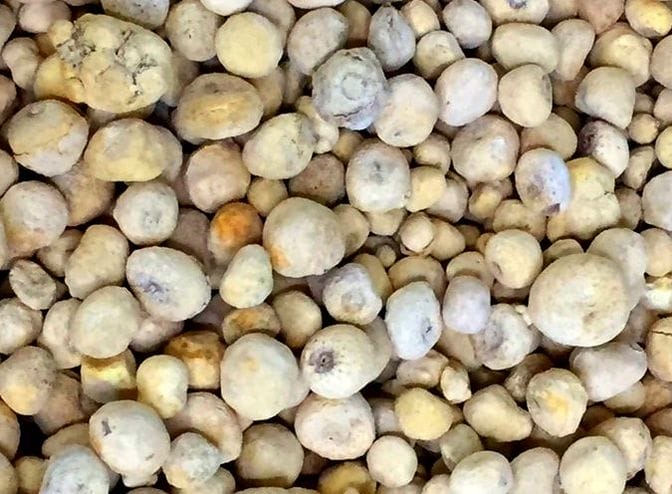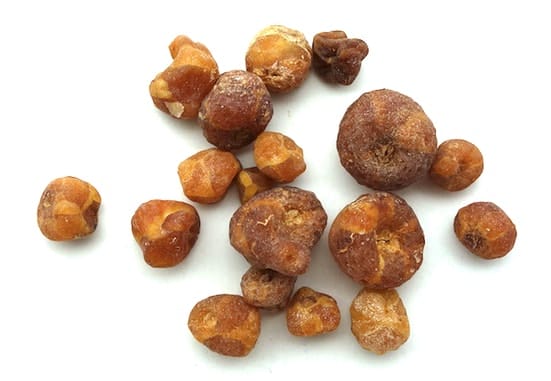Pinellia, Ban Xia 半夏
Prepared Pinellia, Zhi Ban Xia 制半夏
Ban Xia (TCM) Blume, Rumphia, 1835
Blume, Rumphia, 1835

|

|
 Prepared Pinellia Fa Ban Xia as commonly used in the West (Adam, 2017)
Prepared Pinellia Fa Ban Xia as commonly used in the West (Adam, 2017)Botanical name:
Pinellia ternata
Parts used:
Prepared Rhizome
Temperature & Taste:
Very Warm, dry. Pungent. Toxic
Classification:
P. Clear Cold Phlegm
Uses:
1. Dries Damp, Clears Cold-Phlegm:
-Cough with copious sputum; Thick white sputum
-Phlegm or Damp associated with Spleen deficiency
-main medicine for Phlegm and Damp diseases in TCM
2. Stops Vomiting and Nausea, Directs Qi Downward:
-Nausea and Vomiting from excess Phlegm and rising Stomach Qi
-can be used for any type of Nausea and Vomiting depending on the medicines its combined with
–focal distention in the chest and epigastrium
3. Clears Phlegm, Reduces Masses:
-Phlegm-type Scrofula, Nodes and Kernels in the skin
Dose:
Only the prepared product should be used internally.
Decoction: 3–9 grams
Powder: 500mg–2 grams
Preparation:
A number of different preparations are used. Only prepared Pinellia Ban Xia is used internally, and is obtained that way on the Chinese medicine market. The primary methods of processing used today combine either Alum and Ginger, or Lime and Licorice.
1. Raw (unprocessed) Pinellia (Sheng Ban Xia):
Toxic, only used externally for swelling and pain.
Traditionally, raw Pinellia was sometimes decocted after soaking well without further preparation. In this case it is boiled for an extended period of time (2 hours), as in the case of Aconite. This is generally no longer done.
2. Traditional Processed Pinellia
The raw tubers were rinsed well in water 7–10 times to remove irritants. Then they were sun-dried.
While this does reduce irritant effects, later generations created better methods of preparation as shown below.
3. Alum-processed Pinellia (Qing Ban Xia):
Purified by being soaked and boiled, or soaked in Alum solution to remove toxicity. It is drying and used for Damp and Cold-Phlegm.
4. Prepared Pinellia (Fa Ban Xia):
Raw Ban Xia rhizome (100 parts) is soaked to reduce the numbing sensation, then it is soaked in a decoction of Lime (10 parts) and Licorice (15 parts) until the center becomes yellow and the rhizome is semi-transparent and horn-like. This is the standard product available in the west.
5. Ginger Pinellia (Jiang Ban Xia):
The rhizome is soaked as before; then it is boiled with fresh Ginger and Alum until cooked through. This is more warming, more drying, and better for Cold-Phlegm.
6. Lime-processed Pinellia;
Processed with Lime powder after it has been soaked and boiled.
7. Bamboo juice Pinellia (Zhu Li Ban Xia):
Raw or processed Pinellia Ban Xia is soaked in Bamboo juice and dried. This reduces its heat and makes it effective for Phlegm-Heat Cough, Vomiting due to Stomach Phlegm-Heat and Phlegm-Heat blocking internally.
8. There are several other traditional variations of preparation.
Main Combinations:
1. Cold-Phlegm and Damp diseases:
i. Pinellia Ban Xia with Tangerine peel Chen Pi and Poria Fu Ling., Honey-fried Licorice (Zhi Gan Cao) (as in Er Chen Tang)
ii. with Spleen and Qi deficiency, Pinellia Ban Xia with Ginseng, Atractylodes Bai Zhu, Tangerine peel Chen Pi
2. Internal Damp with external Wind-Cold (inc. indigestion, acute gastroenteritis, food poisoning, traveller’s diarrhea) combine Pinellia Ban Xia with Pogostemon Huo Xiang, Angelica Bai Zhi, Citrus Chen Pi, Atractylodes Bai Zhu, Perilla Zi Su Ye, Areca Da Fu Pi (as in Huo Xiang Zheng Qi San)
3. Phlegm-Heat of the Lungs with Coughing of yellow sputum:
i. Pinellia Ban Xia with Scutellaria Huang Qin.
ii. Pinellia Ban Xia with Platycodon Jie Geng, Coltsfoot (Kuan Dong Hua), Scutellaria Huang Qin
4. Wind-Cold Cough or Wheezing, Pinellia Ban Xia with Ephedra Ma Huang, dry Ginger,
5. Asthma:
i. Pinellia Ban Xia, Ephedra Ma Huang, Coltsfoot (Kuan Dong Hua), Schisandra Wu Wei Zi, Mulberry root-bark (Sang Bai Pi)
ii. Pinellia Ban Xia, Ephedra Ma Huang, Coltsfoot (Kuan Dong Hua), Apricot kernel (Xing Ren), Scutellaria Huang Qin, Licorice (as in Ding Chuan Tang)
6. Phlegm and Qi obstruction with feeling of obstruction in the Throat, nausea, vomiting, Pinellia Ban Xia with Magnolia bark (Hou po), Poria Fu Ling, fresh Ginger, Perilla leaf Zi Su Ye (as in Ban Xia Hou Po Tang)
7. Nausea and Vomiting:
i. Cold-Phlegm with Nausea, Vomiting, combine Pinellia Ban Xia with dry Ginger.
ii. from Stomach Heat, Pinellia Ban Xia with Coptis Huang Lian.
iii. from Damp-Cold, Pinellia Ban Xia with fresh Ginger, Magnolia Hou Po, Atractylodes Cang Zhu, Pogostemon Huo Xiang
8. Severe Nausea and Vomiting during pregnancy, Pinellia Ban Xia with Amomum Sha Ren
9. Spleen Qi deficiency with Phlegm and Damp:
i. Pinellia Ban Xia, Citrus Chen Pi, Atractylodes Bai Zhu, Poria Fu Ling, Codonopsis Dang Shen, Licorice (as in Liu Jun Zi Tang)
ii. with more severe Cold and Qi stagnation, add Amomom Sha Ren and Costus Mu Xiang (as in Xiang Sha Liu Jun Zi Tang)
10. Food Stagnation with Phlegm, Pinellia Ban Xia, Citrus Chen Pi, Hawthorn fruit (Shan Zha), Fermented Leaven Shen Qu, Poria Fu Ling, Forsythia Lian Qiao (as in Bao He Wan)
11. Wind-Phlegm Dizziness and Vertigo, Pinellia Ban Xia with Atractylodes Bai Zhu, Gastrodia Tian Ma, Citrus Chen Pi, fresh Ginger (as in Ban Xia Bai Zhu Tian Ma Tang)
12. Phlegm masses, Scrofula, Lymphadenitis, Pinellia Ban Xia, Sargassum Hai Zao, Kelp (Kun Bu), Laminaria Hai Dai, Citrus Qing Pi, Forsythia Lian Qiao, Fritillaria Zhe Bei Mu, Licorice (as in Hai Zao Yu Hu Tang)
13. Chills and Fever with sore throat, nausea, or Malarial Fever, Pinellia Ban Xia with Bupleurum Chai Hu, Scutellaia Huang Qin, Ginseng (or Codonopsis), Honey-fried Licorice, fresh Ginger, Jujube (Da Zao) (as in Xiao Chai Hu Tang)
14. Cholecystitis, Pinellia Ban Xia, Citrus Zhi Shi, Scutellaria Huang Qin,
Major Formulas:
Ban Xia Hou Po Tang
Ban Xia Bai Zhu Tian Ma Tang
Bao He Wan
Chai Hu Gui Zhi Tang
Chai Hu Jia Long Gu Mu Li Tang
Da Chai Hu Tang
Ding Chuan Tang
Ding Xian Wan
Er Chen Tang
Gan Cao Xie Xin Tang
Gou Teng San
Hai Zao Yu Hu Tang
Huang Lian Wen Dan Tang
Huo Xiang Zheng Qi Shui
Liu Jun Zi Tang
Mu Xiang Liu Qi Yin
Qing Qi Hua Tan Wan
Wen Jing Tang
Xiang Sha Liu Jun Zi Tang
Xiao Chai Hu Tang
Xiao Qing Long Tang
Cautions:
1. Very drying. Not suitable for Yin deficiency
2. Not suitable for Dry Cough and Coughing Blood
3. Only the prepared rhizome should be used internally.
4. Use cautiously in pregnancy, avoid full doses.
Toxicity:
1. Toxicity is primarily due to Calcium Oxalate crystals and Lectins.
2. A 4 week repeated-dose toxicity study in rats with water extracts of Pinellia Ban Xia at doses up to 2000mg/kg/day showed no ill effects (see here)
3. 6 gm/kg/day of Pinellia Ban Xia for 10 days given to rats showed changes in phospholipid metabolism, amino acid metabolism and carnitine metabolism. No Liver or Kidney toxicity was noted. (see here)
4. Alum solution is used in the preparation of Pinellia Ban Xia and has been shown to attenuate toxicity.
Antidotes:
1. A strong decoction of fresh Ginger can be taken to neutralize the toxicity in case of overdose.
Drug Interactions:
Not used with Aconitum species.
